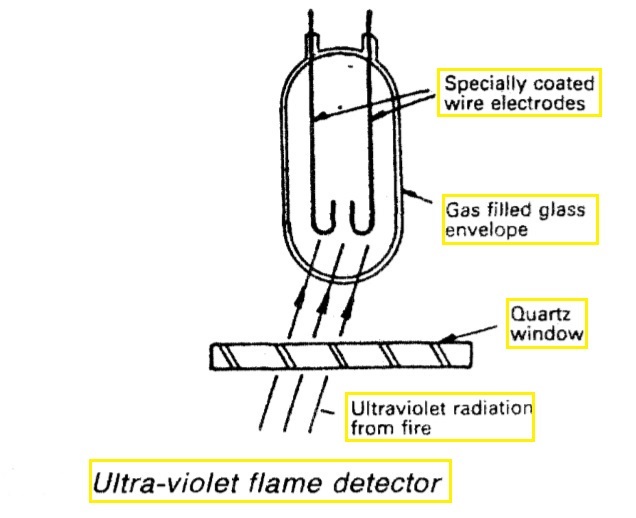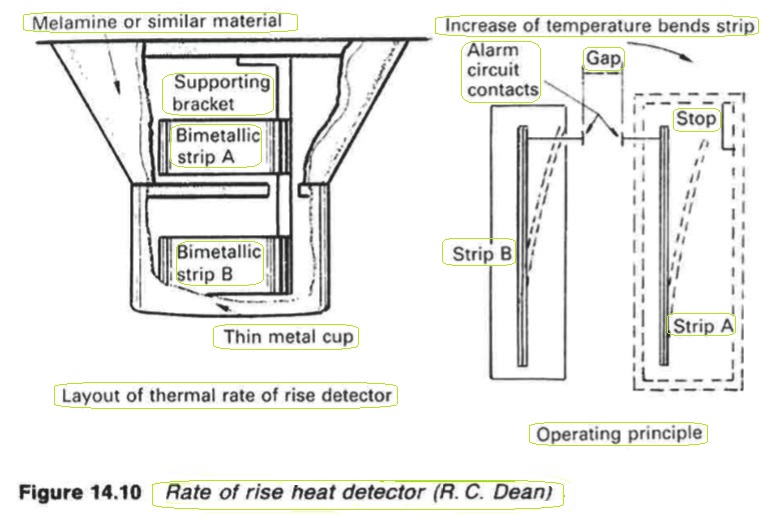
Home page||Fire protection||
Fire Detectors for unmanned machinery spaces of cargo ship
A variety of devices are available for detecting fire in unmanned machinery
spaces but each has an ability to detect basically only one aspect. Thus, smoke
detectors based on the ionization chamber are able to recognize combustion
products but will not register radiation from a flame or heat.
A smoke detector
based on the interruption of light reception by a photo-electric cell, will only
identify the shadow effect of dark smoke when it passes through its chamber. It
will not identify unseen combustion products, heat or flame. Heat sensors and
rate of temperature rise sensors based on the differential expansion of bimetal
strips will detect only heat. Flame detectors may not detect a flame which is
hidden by equipment and are sometimes caused to operate by sources of
radiation other than from a flame.
Each device has a limited ability to detect a feature associated with fire so
that systems are likely to have more than one type of device. Watchkeepers can
detect fire by seeing flames and smoke, smelling combustion products and
feeling heat
lonization chamber combustion products detectors
Within machinery spaces, ionization chamber combustion products detectors
(Figure 14.6) are the type most used. These devices monitor the electrical
change which occurs when combustion particles reach the open chamber of the
detector.

Figure : Ionization chamber combustion products
Air in the open and closed chambers conducts a small electric leakage level
current from the low pressure d.c. supply, because it is ionized by alpha
particles emitted from a small piece of enclosed radium. Any combustion
products reaching the open chamber, reduce the conductivity. The increased
resistance to current flow across the open chamber air gap, causes a rise in
potential which triggers the electronic device and switches on a full current
flow in the alarm circuit.
Operation of any or all of the devices will operate the
one alarm. The indicator light shows which device has functioned so that the
source of combustion products (sometimes not visible) can be located. The
indicator light provided on the sensor body is also used for testing with gas
from a test canister or cigarette smoke.
The appropriate number of detector heads are sited in strategic positions
above equipment which is a fire risk and at deckhead level in the protected
compartment.
Obscuration type smoke detectors
A simple photo-cell and light arrangement (Figure 14.7) can be used as a
detector for visible smoke but this type of device would not detect invisible
combustion products.

Figure : obscuration type smoke detector
Flame detectors
Photo conductors sensitive to infra-red light (Figure 14.8) or photo-emmissive
cells (Figure 14.9) which are sensitive to ultra-violet light, can both be used for
flame detection. Light may be directed through a filter, on to the detecting
surface by a wide angle lens.

Figure : Infra red flame detector

Figure : Ultra violet flame detector
A rotating mirror can be incorporated to extend
the area under surveillance. The radiation increases conductivity so that current
flow increases and causes an alarm circuit to be triggered. To reduce the chance
of false alarms from light sources other than flame, a capacitor and a coil are
connected in series, such that only current fluctuations, with a frequency similar
to that of flames, are passed.
Heat sensors
Bimetal strips made up from brass and INVAR will deflect when heated due to
the high expansion coefficient of the brass and the low expansion coefficient of
the INVAR, which is 36% nickel steel. Deflection increases with temperature
and could in itself be used to complete an electrical circuit and operate an alarm
at some specific figure. However, rate of rise can be detected using two bimetal
strips (Figure 14.10) of different thickness. These are set up parallel to each
other and arranged to deflect in the same direction.
Rapid temperature rise will
cause the thinner element to deflect more quickly than the other, so causing
contact to be made and the alarm circuit to be completed. A slow rise causes a
similar deflection in both elements, so that a gap between the contacts persists,
until a certain maximum temperature is reached when contact is made because
of other differences in the make up of the strips.

Figure :Rate of rise heat detector (R. C. Dean)
Detection system
The control equipment associated with the installation may be accommodated
in the wheel house or in a fire control centre and comprises a fire indicating
cabinet to which the detector heads are connected, a power unit, to convert the
incoming ship's supply to the voltage appropriate to the equipment and a
standby battery unit. The cabinet will indicate in which space a fire has been
detected and will also monitor the system and indicate whether a fault has
developed. It will also instigate an audible alarm.
Summarized below general cargo ship fire protection equipments & guideline:
- Fire main system & related mechanism
The fire main
extends to the full length of the ship and from the machinery spaces to the
highest levels. Hydrants served by the main, are situated so that with suitable
hoses any area on the ship can be reached.
.....more
- CO2 fire extinguishing installation
Fire extinguishing installations employing CO2 stored under pressure at
ambient temperature are extensively used to protect ships' cargo compartments,
boiler rooms and machinery spaces. When released the CO2 is distributed
throughout the compartment, so diminishing the relative oxygen content and
rendering the atmosphere inert.
...... more
- Fire fighting equipments
Two independently powered pumps must be provided in all cargo ships of 1000 tons gross and over and in passenger ships of less than 4000 tons gross. Larger passenger vessels and passenger ferries must have three such pumps. The pumps are fitted with non-return valves if they are of the centrifugal type, to prevent loss of water back through open valves when not running.
..... more
- Details of fire detectors
A variety of devices are available for detecting fire in unmanned machinery
spaces but each has an ability to detect basically only one aspect. Thus, smoke
detectors based on the ionization chamber are able to recognize combustion
products but will not register radiation from a flame or heat.
.....more
- Machinery space fire & use of Walter Kidde CO2 system
Walter Kidde CO2 system employs pilot
CO2 cylinders to open the distribution system main stop valve and
subsequently the valves on the individual CO2 cylinders.
.....more
- Fire protection system for cargo holds
Holds for general cargo, have been protected against fire by fixed installations which deliver inert gas from an inert gas generator based on combustion of fuel (similar to the system available for inerting oil tankers) and halon systems.
.....more
- Low pressure CO2 storage
In some installations, the CO2 is stored in low pressure refrigerated tanks. The
cylindrical storage vessels are fabricated to the pressure vessel
requirements of the authorities. The tanks are of low temperature steel, fully
tested and stress relieved. They are mounted on supports designed to
withstand shock from collision.
..... more
- Halon system
Halon 1301 has the chemical formula CF3 Br being known as bromo-trifluoromethane.
It is a colourless, odourless gas with a density five times that of air and
extinguishes fire by breaking the combustion chain reaction.
.....more
- Multi-spray system for the machinery spaces
This system is similar to the sprinkler used in accommodation areas but the spray heads are not operated automatically. The section control valves (Figure 14.20) are opened by hand to supply water to the heads in one or more areas. Ready to use hoses can also be supplied. Fresh water is used for the initial charging and the system is brought to working pressure by means of the compressed air connection.
.....more
- Automatic sprinkler system
A network of
sprinkler heads is arranged throughout the spaces to be protected. Each sprinkler head is normally kept closed by a quartzoid bulb which is almost filled with a liquid having a high expansion ratio.
.....more
- Details various portable extinguishers & how to use ?
The first line of defence against fire in any area of the ship, is the portable fire extinguisher. Some common portable extinguishers that have been used at sea are described.
.....more
Home page||Cooling ||Machinery||Services ||Valves ||Pumps ||Auxiliary Power ||Propeller shaft ||Steering gears ||Ship stabilizers||Refrigeration||Air conditioning ||Deck machinery||Fire protection||Ship design
||Home ||
General Cargo Ship.com provide information on cargo ships various machinery systems -handling procedures, on board safety measures and some basic knowledge of cargo ships that might be useful for people working on board and those who working in the terminal. For any remarks please
Contact us
Copyright © 2010-2016 General Cargo Ship.com All rights reserved.
Terms and conditions of use
Read our privacy policy|| Home page||




